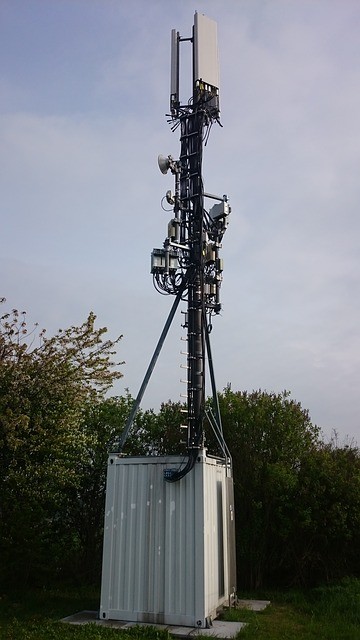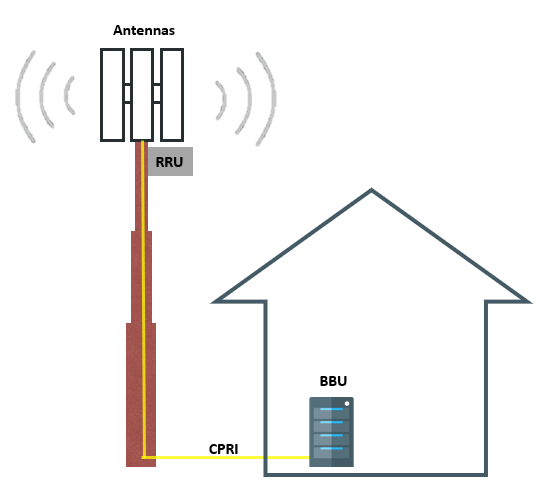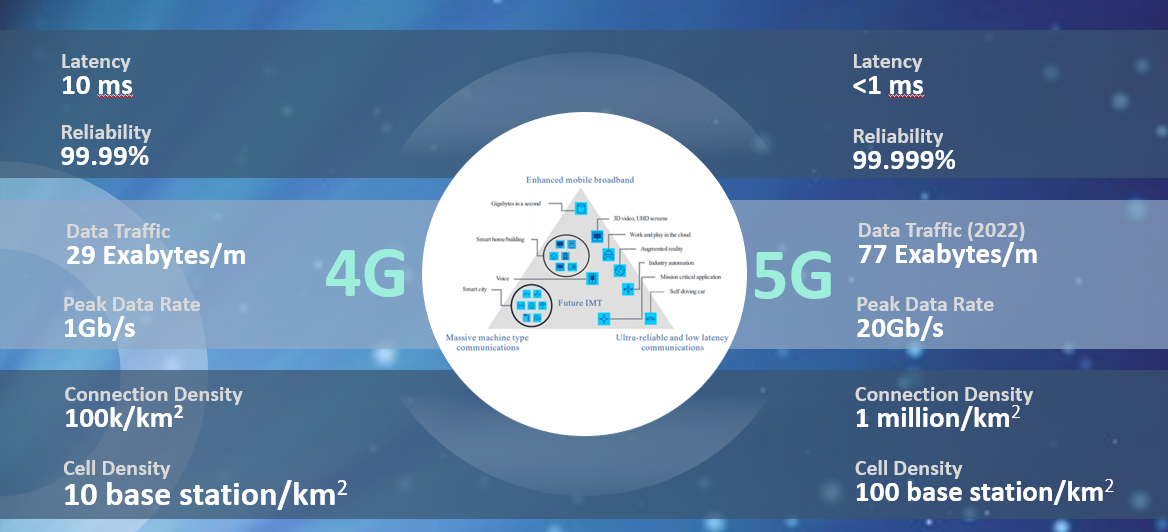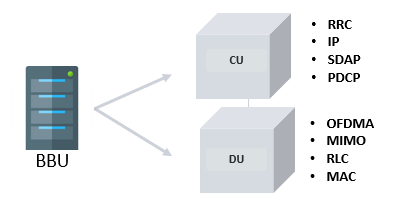What is C-RAN? The Evolution From D-RAN to C-RAN
By Sean Hsu

Who came up with C-RAN?
Centralized Radio Access Network or C-RAN, was first introduced by the China Mobile Research Institute in 2010 in an effort to create a new cloud computing architecture for supporting a the 5G Mobile network. C-RAN breaks apart the traditional cell-based network infrastructure into separate parts that meet the requirements of 5G, while supporting the existing 2G, 3G, and 4G infrastructures. It includes a centralized processing, collaborative radio, and real-time radio networking.
The Building Blocks of RAN

Traditionally, a Radio Access Network (RAN) consists of a group of Base Stations (BS) or NodeB (NB), usually sprinkled on top of buildings to form a cell network, which provided wireless access to mobile users. It is composed of an antennas, radio frequency (RF) equipment, digital processors, and baseband units.
The base stations are used to interconnect phone signals between a user's device and the core network. When a mobile device is connected to the nearest cell tower, it was the base station's job to transmit the traffic (voice, data, video traffic) to the core network owned by the telecom company.

The base station is made up of two separate parts that will function individually called the Baseband Unit (BBU) and the Remote Radio Unit (RRU) or Remote Radio Head (RRH). When the signal arrives at the base station, the RRU retrieves the signal or radio frequency from the antenna and creates the analog transmitted RF to the baseband unit. Then the BBU refers to the original frequency range of a transmission signal before it modulates, generates, and processes the digitalized signal. Functions such as de(coding) and de(modulation) are done in this part as well. In other words, BBU handles most of the digital processing while the RRU takes care of the analog side of things. The combination of both units at the cell site is called a Distributed-RAN (D-RAN) architecture.
Beginning from D-RAN
In a D-RAN architecture, the whole base station is located at the cell tower site. The RRUs are located at the top of the tower next to the antennas and the BBUs are located in an equipment room not too far from the tower itself. The RRUs and BBUs are directly connected via CPRI or Common Public Radio Interface, meaning that for every one RRU there will be one BBU connected to process the data.

Although simple, D-RAN presented several issues for telecoms especially in terms of managing the space and capacity needed at the base stations. Most of the base stations were deployed to meet peak capacity periods for that region. However, peak periods come and go, so there were often be times where that processing capacity was underutilized. There's also the issue of the need to meet short bursts of traffic (for example, if there's a concert or event nearby), the RRUs and BBUs were not designed for this type of flexibility.
CRAN: BBU Pooling and Virtualization

In a C-RAN architecture, the base station is split up. The RRUs stays at the cell site, while the BBUs are aggregated into a centralized office, sometimes called a BBU hotel, with a centralized controller to process calculations digitally. This concept breaks the 1:1 connection between RRU and BBU, virtualizes the heavy-loaded baseband calculation, and brings key functions to the central office, which is much closer and convenient for the telecoms to manage. Also, by aggregating all the BBUs, telecoms can better organize their computing resources, which can reduce the costs on the maintenance of the 5G network.
The virtualization technologies facilitate the logical isolation of resource while the physical resources are shared in dynamic and scable way. In the context of C-RAN, network virtualization is done at the BBU pool level including network, computing and storage. Each BBU is a virtual node while the communication between them are virtual links. The pool operates on one machine sharing CPU, memory and network resources between multiple BBUs.
Advantages of Centralized BBU in C-RAN (BBU pooling)
Centralizing the BBUs come with several advantages, including resource virtualization, better service deployment at the edge and the potential to utilize advanced technologies that require high processing power. With BBU pooling, joint processing and cooperative radio sharing will become possible.
In the traditional network, the BBU is located far from the central office usually spanning across several roof tops or at the cell tower, which are difficult or costly to maintain. As BBUs are brought closer to the central office, they can potentially be placed inside secured data centers. This would improve data security and would allow for more efficient data processing for more extensive computations. With multiple BBUs sharing a common processing pool, its resources can be utilized more effectively with less power consumption and as well as allowing access to larger amounts of resources when needed.
Lastly, by pulling together resources at central offices, services can be deployed on the network edge instead of the core. By moving service closer to the user, telecoms gain faster responses with edge computing while reducing the bandwidth needed for backhaul traffic.
The Fronthaul Network Transition to 5G C-RAN
With 5G, the design of BBU pooling is faced with another issue. The transport requirements of 5G vastly surpasses that of 4G. Here are some of the differences between 4G and 5G.

Meeting the requirements of 5G meant changes had to be made to the fronthaul network, in particular the use of CPRI between RRUs and BBUs. The CPRI standard defines an interface between the Radio Equipment Control (REC) and the Radio Equipment (RE), which is mostly used to carry data between cell sites and base stations. Since, CPRI was not designed to meet the timing, latency or efficiency requirements of 5G, eCPRI was developed specifically for 5G fronthaul transport.
Fiber is the preferred choice recommended from the C-RAN community due to the higher bandwidth requirement, however, cellular or millimeter wavelength do offer cheaper and easier deployment, but at higher latency.
5G from C-RAN toward O-RAN
Past RAN architectures (3G/4G) constructed their NodeB (NB) and eNodeB (eNB) based on monolithic building blocks. However, 5G introduced massive MIMO (multiple-input, multiple-output) to overcome the high data rate and low latency requirements. It combined the RRU and the antenna into an Active Antenna Unit (AAU), which hangs on top of the antenna system. This reduced the signal loss caused by the transmission of multiple antennas to the RRU.

Within the 5G RAN, the BBU can be split into the Distributed Unit (DU) and the Centralized Unit (CU). The DU runs close to the RRU and is responsible for real-time Layer 1 (Physical) such as OFDMA and MIMO as well as the Layer 2 scheduling functions such as RLC (Radio Link Control) and MAC (Media Access Control). RLC contains ARQ and HARQ to support the re-transmission functions and the MAC mainly provides QoS (Quality of Service) features.
The logical node includes a subset of the eNB/gNB functions, depending on the functional split option, and its operation is controlled by the CU. The CU is a centralized unit connected between the 5G core network and the DUs. It provides the access control and coordinates high-level protocols including RRC (Radio Resource Control) from the control plane and IP, SDAP (Service Data Adaptation Protocol), PDCP (Packet Data Convergence Protocol) from the user plane. SDAP is a new protocol aimed at the QoS flow for the user’s access to the 5G network. PDCP compresses and decompresses the IP headers and maintains the wireless payload integrity of the sequence.
Conclusion
To lower cost, improve performance, and scale up baseband processing from the base station, C-RAN has come to the center stage. It separated the BBU and RRU from the base station. It centralized the BBU into a shared resource pool for heavy computation with virtualization from the cloud. It removed the real-time function from the BBU and integrated it into an AAU box. Furthermore, the pooled resources makes it easier to deploy services at the edge, which improves user satisfaction, improves resource utilization, and reduces the pressure of backhaul traffic.
To learn more about UfiSpace's 5G RAN solutions, please contact our sales team.
